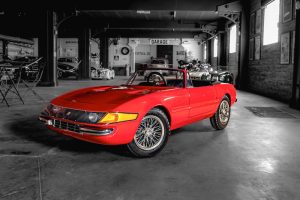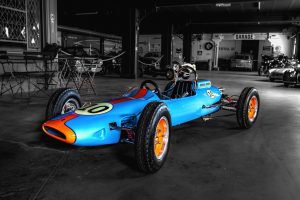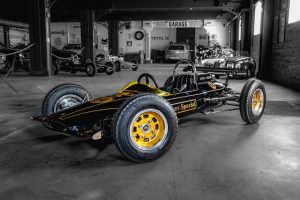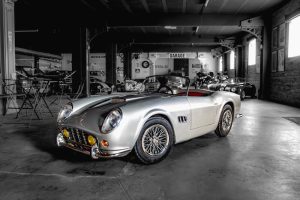20/11/2023 https://passion.axa.fr/collection/actualites/junior-cars-europe-rudy-servol
If you are a regular at Le Mans Classic, you have certainly noticed those little sports cars driven by children during the “Little Big Mans” parade. These miniature replicas of legendary models delight children… but also vintage car enthusiasts. Heading Junior Cars Europe, Rudy Servol markets these cars in Europe, produced in small series and highly sought after by collectors. This enthusiast is also a high-level race car driver.
Passionate about motorsports, you compete in the French GT Championship alongside Nicolas Prost. Can you describe your journey from motorcycle racing to car racing?
I started with a career in motorcycle racing, reaching the doors of the French national team. I competed in various categories up to the European Superstock Championship. However, when I had to choose between my sports career and my professional activities, I decided to prioritize the latter. At that time, I was managing a business for renting and then selling campervans, vans, and converted vans. A few years ago, I was offered a chance to race in a Peugeot Sport 206 event, where I achieved good results.
The following year, I joined a team with which we won three races that year. I then spent three seasons in the French Mitjet Series Championship and participated in a few races in the Legends Cars Cup. In 2014, I returned to the French Supertourism Championship. After a break, Team Alpine / CMR approached me in 2019 to support their professional drivers in the French GT Championship. This is now my third season alongside Nicolas Prost (son of Alain Prost, editor’s note). We have had very good results and have just signed with Porsche.
When did you decide to start importing cars for children?
A few years ago, I was looking for a scale replica of a legendary model for my 5-year-old son. I realized that in France, only very expensive or poorly finished vehicles were available. Initially, I considered manufacturing such cars myself but quickly understood that producing them in France was not economically viable. Then one day, my teammate Nicolas Prost showed me a photo of a replica of a famous Formula 1 car driven by Jim Clark, which he had bought for his son.
After buying the car from him, I became interested in the manufacturer, the Harrington Group. I found that their models were scarcely distributed in Europe and decided to start distributing them two years ago. With my associate Roger Nunez, a former Michelin Competition employee (Formula 1, MotoGP…), we became exclusive importers for Europe. We marketed the first models a year ago and sell about fifteen cars per year.
Can you describe the ranges of cars you offer?
We offer 1:2 scale replicas of legendary models from Italy and the UK. The small sedans we sell, in two-seater models, are replicas of cars that raced in the 24 Hours of Le Mans. Thus, they are eligible for the “Little Big Mans” race, an extraordinary event in which we participated this year. Each sedan model has its specific features: some have adjustable steering wheels, others have sliding seats…
For the single-seaters, they are replicas of cars that have won the Formula 1 World Championship, driven by illustrious drivers like Jacky Ickx or Jim Clark. The manufacturer has made a point of staying as close as possible to the original cars. All single-seaters are built on the same base, with only the decorations changing from model to model. Two models have a rear wing, and we also offer the Gulf decoration, with blue and orange stripes, which is very popular, even though it never existed in Formula 1.
These cars are very impressive… What are their technical specifications?
These models are equipped with features worthy of real race cars of the time: adjustable suspensions, camber and caster angle adjustments, a detachable steering wheel, adjustable pedal depth, disc brakes… The interiors are leather, and some steering wheels are made of Bakelite.
For safety reasons, we limit the speed of the models we sell in Europe to 20 km/h. They can be driven by children from 8 years old or by adults. We currently only import petrol-powered models (4-stroke engines) with an automatic clutch and three speeds.
We chose this type of engine for several reasons: importing electric models into Europe would require various certifications. Additionally, petrol engines can start easily even after long periods of disuse, unlike electric batteries which can degrade and, in the case of lithium batteries, present certain potential risks.
How are the cars manufactured?
The cars are hand-made in Vietnam. They are metal cars, just like the authentic models. All parts are custom-made with impressive finishing, making them closely resemble the legendary models they evoke. James MacLachlan, a former British driver now heading Harrington Group’s Junior Cars division, pays great attention to detail. Harrington initially specialized in bumpers for classic cars. They have a fiberglass workshop, a mechanical workshop, a body shop… The factory produces no more than 8 to 10 cars per month, which is why delivery often takes more than a year.
What is the selling price of these vehicles? Why are they so sought after?
The single-seaters are sold for an average of around €14,900 excluding tax, and the sedans around €17,500 excluding tax. Since the production capacity of the workshops will not increase, these are rare models whose value will remain high upon resale. By purchasing these vehicles, our clients are also making an investment. For instance, a model inspired by a highly sought-after classic British car was recently sold by RM Sotheby’s for nearly twice its purchase price.
Is customization possible?
Yes, but it extends the delivery time… Clients can choose the color of the interior seats and the exterior body color.
Do you sell limited series?
Harrington released a replica of a British car made famous by James Bond, in a limited series of 33 units. We managed to secure 3 or 4 for Europe.
Is it possible to change a part or tires if needed?
Yes. The cars come with a one-year warranty, and all parts are available in stock if needed, at a reasonable cost.
Are the cars subject to standards in Europe?
No, we are not subject to any standards, similar to go-karts, for example. However, we have submitted an approval application to obtain the CE standard for our vehicles.
Do some clients rarely use the cars they purchase?
Indeed. The single-seaters are mostly stored and rarely driven. Some buyers prefer to hang the cars on the wall as art pieces, while others display them in their company’s lobby. This explains why we haven’t had to perform any after-sales repairs so far.
At what events can we see your cars?
Our cars have appeared at events like the Chantilly Arts & Elegance Richard Mille, the Pau Classic Grand Prix, and Le Mans Classic.
Can the cars be tested before purchase?
We have a few models in stock, mainly for communication/marketing purposes. However, no buyer has asked to test the models before purchase so far. Most decide in a matter of seconds, on a whim, without delving much into the technical details of the vehicle they are buying…
Do you plan to expand your catalog?
Harrington is working on developing a new model, but creating a new reference requires a minimum investment of €35,000 to €40,000. This explains why the group offers so few models.
The First Junior Cars
DE LA CHAPELLE
Les Automobiles De La Chapelle began building their first junior cars in 1979, 6:10 scale reproductions of iconic Bugatti, BMW, or Ferrari models for children. The cars, unique and numbered, are entirely handmade. Their value continues to rise at auctions. For instance, in 2018, a De La Chapelle Junior chassis number 125 was sold for over €33,000 by Bonhams, and in 2021, chassis number 28 of the same series reached €120,000 under the hammer at RM Sotheby’s…
THE BUGATTI BABY
Industrialist and inventor Ettore Bugatti created the Bugatti Baby in 1925 for his son, a true Bugatti for children at 1:2 scale. First presented at the Milan show in 1927, the model was later offered to the children of the brand’s clients, often royalty and celebrities. Equipped with an electric motor powered by a 12-volt battery and connected to the rear axle by a crown gear, the “Baby” could reach a speed of just over 15 km/h. It was produced in a small series of around 500 units. Highly prized, these models are now highly sought after by collectors, often fetching over €100,000 at auctions…
Little Big Mans
A parade at Le Mans Classic, open to children aged 7 to 12 driving petrol or electric-powered cars, miniature replicas of models that have made the 24 Hours of Le Mans famous. No ranking is established at the end of the race.
Mitjet Series
The goal is to allow a wide audience to participate in car races at a lower cost.
Legends Cars Cup
Competitions featuring hot rods with 1930s/40s looks.





